Amber Fossils Provide Evidence of Cretaceous Frogs Inhabiting Wet, Tropical Environments
The remains of four tiny frogs preserved in Cretaceous-aged amber from northern Myanmar have provided palaeontologists with the first definitive evidence showing frogs 99 million years ago were inhabiting wet, tropical environments. Cretaceous amber reveals its secrets.
Preserved in Cretaceous Amber – A Window into an Ancient Terrestrial Ecosystem
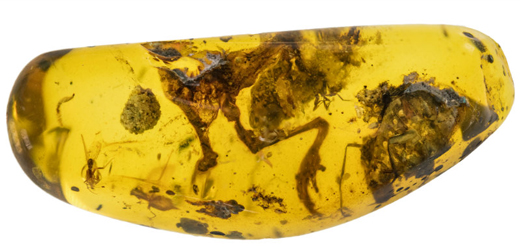
Picture credit: University of Florida
Electrorana limoae
The new species of Cretaceous amphibian has been named Electrorana limoae. It was small, a juvenile, measuring around twenty millimetres in length, but this frog and other amazing fossil finds from Myanmar amber (burmite), some of which have been documented on this blog, provide scientists with an improved understanding of the micro-flora and micro-fauna of a tropical forest ecosystem that existed some ninety-nine million years ago.
The frog fossils provide the earliest irrefutable evidence of these types of amphibian living in wet, tropical forests. They are the oldest-known examples of frogs preserved in amber.
Co-author of the study, published earlier this week in Nature’s “Scientific Reports”, David Blackburn (Florida Museum of Natural History) stated:
“It’s almost unheard of to get a fossil frog from this time period that is small, has preservation of small bones and is mostly three-dimensional. This is pretty special, but what’s most exciting about this animal is its context. These frogs were part of a tropical ecosystem that, in some ways, might not have been that different to what we find today – minus the dinosaurs.”
A Life Reconstruction of Electrorana limoae
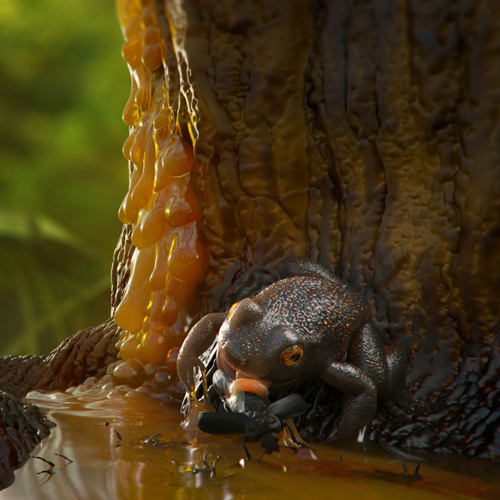
Picture credit: Damir G Martin
Frogs – Probably Very Numerous But a Shockingly Poor Fossil Record
The fossil record for the Class Amphibia is extremely poor, it is believed that frogs may have evolved during the Triassic, although the fossils of an ancient frog/salamander ancestor discovered in Texas in 1995 might indicate that frogs were around many millions of years earlier.
To read Everything Dinosaur’s article about the discovery of a potential ancestral link between frogs and salamanders: Amphibian Ancestry a Little Clearer Thanks to New Discovery.
Frogs tend to be small, as a result their light, often tiny bones are not likely to preserve well so they are very probably underrepresented in the fossil record. What fossils we do have of frogs tend to be biased towards more robust species from arid, seasonal environments, although, if we consider today’s frogs, the bulk of frog diversity can be found in tropical rainforests.
Dr Blackburn added:
“Ask any kid what lives in a rainforest and frogs are on the list, but surprisingly, we have almost nothing from the fossil record to say that’s a longstanding association.”
A Computer-generated Model Showing Frog Bones (white) and the Remains of a Beetle (Orange)
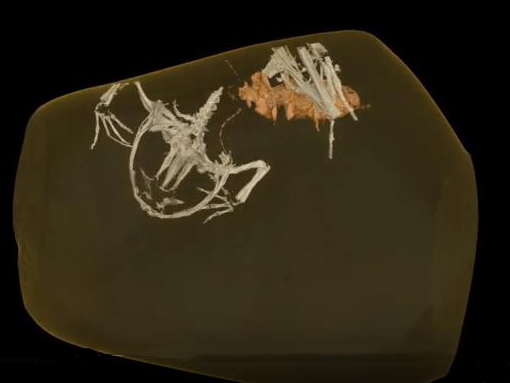
Picture credit: University of Florida
The Burmite Deposits of Myanmar
The Cretaceous amber deposits of northern Myanmar (referred to as burmite), have provided palaeontologists with a unique record of an ancient Cretaceous tropical forest ecosystem. with fossil evidence of mosses, bamboo-like plants, aquatic spiders and velvet worms. The discovery of Electrorana and the other fossils, the first frogs to have been found in burmite, will add to our understanding of frogs in the Cretaceous. These fossils demonstrate that frogs have inhabited wet, tropical forests for at least 99 million years. Frog fossils preserved in amber are exceptionally rare, previous examples have come from the Dominican Republic and Mexico and date back only to about 40 million and 25 million years, respectively.
A View of the Skeletal Remains Preserved in the Burmite
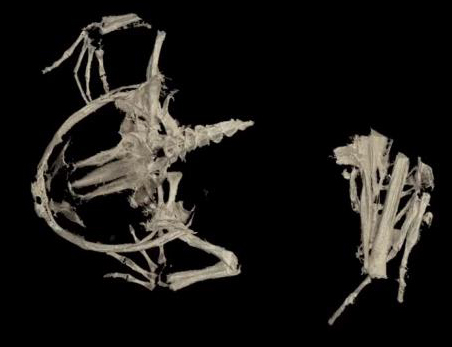
Picture credit: University of Florida
Electrorana is the most well-preserved of the four frog fossils. Clearly visible in the amber are the frog’s skull, its forelimbs, part of its backbone, a partial hind limb. The other amber fossils contain two hands and an imprint of a frog that likely decayed inside the resin.
Answering Some Questions but Raising Many More
Many characteristics herpetologists use to discern details of a frog’s life history and determine how it’s related to other frogs, the wrist bones, the pelvis, hip bones, the inner ear, the top of the backbone, are either missing or were not yet fully developed in the juvenile frog.
The researchers, which include lead author Lida Xing (China University of Geosciences), have postulated that Electrorana limoae had similar features to extant Midwife toads and Fire-bellied toads, Eurasian species associated with temperate ecosystems. Further CT scans and more fossil discoveries could help illuminate ancient evolutionary relationships, possibly clarifying how Electrorana fits into the frog family.
A Computer-generated Image of the Fossils of Electrorana limoae (note the presence of a beetle)
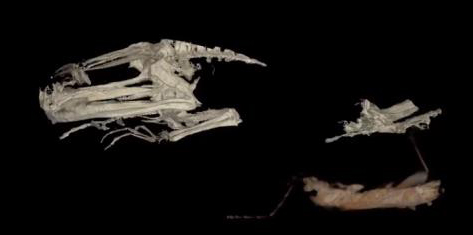
Picture credit: University of Florida
If ecosystems of today are anything to go by, it seems likely that there may be numerous frog fossils awaiting discovery, locked away in burmite. We do not have a lot of single-species frog communities in tropical forest environments in the modern world, so it does seem likely that more frog fossils will be found in northern Myanmar.
Everything Dinosaur acknowledges the help of a press release from the University of Florida in the compilation of this article.
For further news stories about fossil discoveries from Myanmar burmite:
Evidence of insect mimicry preserved in amber: Those Clever Cretaceous Lacewings.
A blood-sucking story: A Blood-sucking Story – Dinosaur Parasites.
The tale of the spiders with tails: A Tale of the Spiders with Tails.
Enantiornithine bird preserved in amber: Watch the Birdie!
Visit the Everything Dinosaur website: Everything Dinosaur.






Leave A Comment